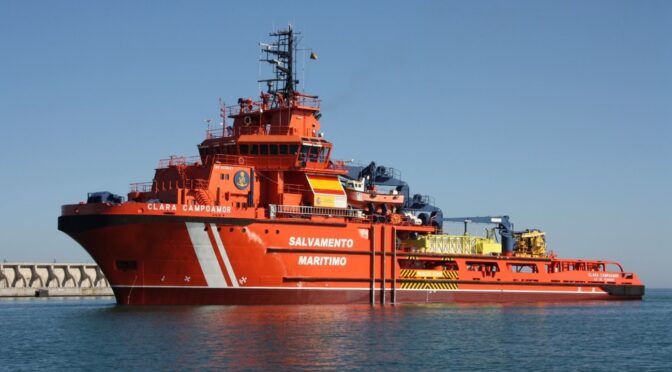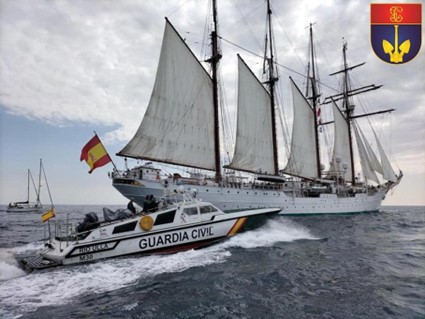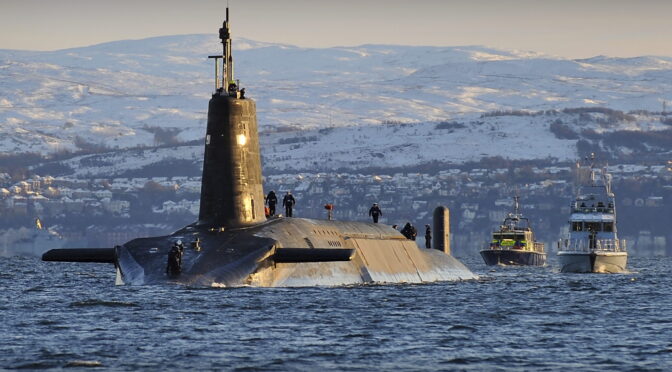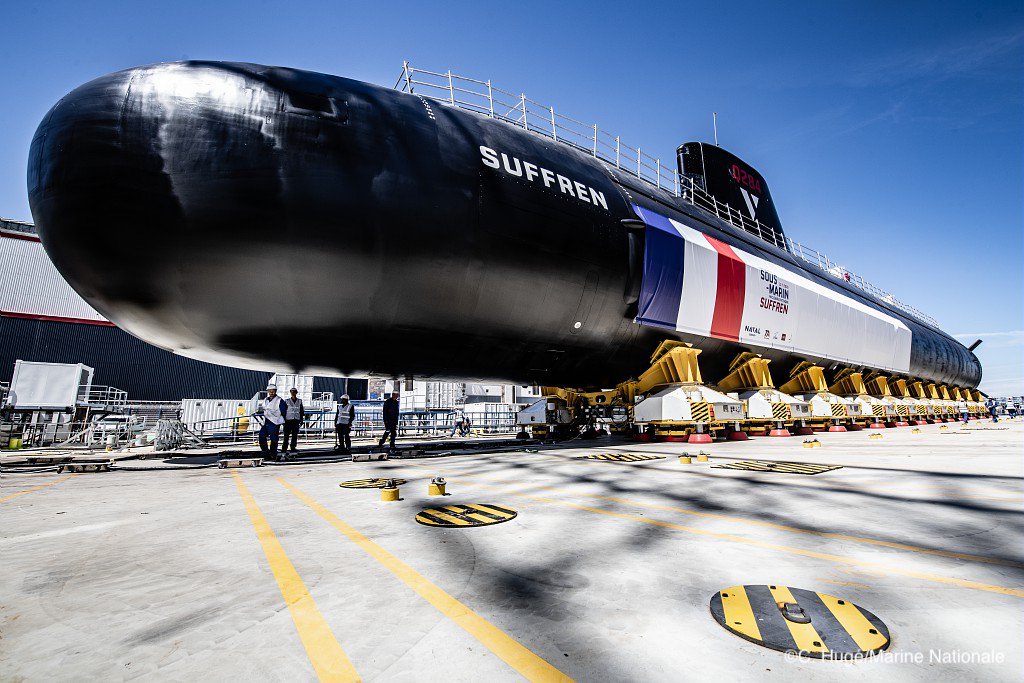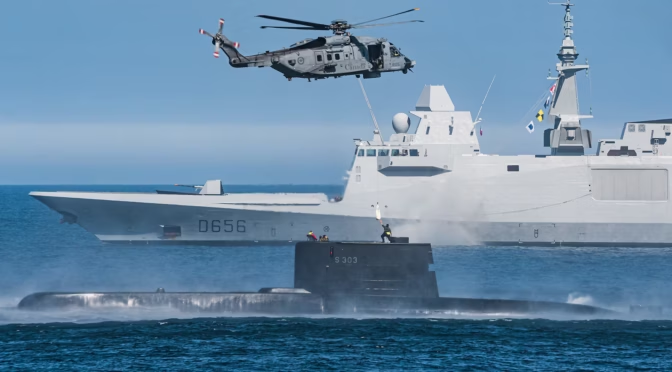By Steinar Torset and Ian Bowers
Despite significant and ongoing losses suffered as a result of its full-scale invasion of Ukraine, Russia remains a significant threat to NATO members. As NATO restructures to address this new reality, NATO’s naval forces must also restructure to both exploit NATO’s enlargement and better address simultaneous threats in NATO’s waters.
The accession of Finland and Sweden into NATO, two states with highly capable navies, has fundamentally changed the alliance’s military maritime geography. The Baltic Sea is now an operational area dominated by NATO members. Nevertheless, it is not yet a NATO lake with Russia, operating out of St. Petersburg and Kaliningrad, capable of creating a range of below-the-threshold and wartime operational effects. At the same time, Russia’s Northern Fleet has largely avoided the force degradation experienced by Russian land forces and continues to pose a challenge in the High North and the North Atlantic.
NATO should create a third Standing NATO Maritime Group (SNMG) dedicated to operations in the Baltic. This would fully exploit the operational benefits of Finland and Sweden joining NATO and take advantage of ongoing force developments in other Baltic NATO navies, including Poland and Germany.
Not only would the new SNMG-3 be drawn largely from Baltic states, but it would also leverage their somewhat bespoke capabilities and regional knowledge. It would also be designed to work closely with regional NATO land and air components, a necessity given the littoral nature of the operating theatre. Furthermore, it would allow SNMG-1 to concentrate fully on its primary area of operations in the North Atlantic without being pulled out of area to manage contingencies and demonstrate presence in the Baltic. NATO will have access to sufficient forces to maintain an extra SNMG and should therefore take advantage of this opportunity.
The Russian Threat in the North Atlantic and the Baltic
At sea, Russia poses a range of threats across the competition continuum to NATO and its members. According to multiple intelligence agencies, Russia’s Northern Fleet, based on the Kola Peninsula, remains fully operational. While doubts persist over the quality of the fleet’s surface assets, particularly for high-intensity combat and sustained operations, there is consensus that Russia’s undersea platforms pose a significant threat to the alliance. Not only do they have potent warfighting capabilities, but they enable and conduct hybrid operations such as disrupting undersea infrastructure.
At the same time in the Baltic, Russia’s Baltic Fleet and civil maritime presence poses if not an equal but still potent threat to NATO interests. Although Russia is isolated, with every other littoral state a member of NATO, this does not mean the Baltic is a so-called NATO lake. The Baltic fleet and Russian civil and shadow maritime presence have a range of hybrid and traditional warfighting capabilities. The numerous cases of disruption to undersea cables are likely examples of this capability.
The Russian enclave of Kaliningrad presents a significant if not insurmountable challenge to NATO forces. In particular, Russian aircraft, anti-ship, and anti-air missiles deployed at Kaliningrad present an ever-present risk to NATO maritime and air forces. NATO’s solution to this problem is likely a joint approach where a combination of the maritime, land, and air components allow NATO to establish and maintain an advantage.
NATO’s Current Maritime Posture
NATO’s primary warfighting force at sea in the North Atlantic and the Baltic Sea is SNMG-1. SNMG-1’s overarching wartime mission is to secure transatlantic SLOCs and conduct operations on NATO’s northern flank to establish limited sea control or conduct sea denial activities in areas vital to NATO’s reinforcement. In competition and crisis phase operations, SNMG-1 is tasked with participating in exercises, contingency response, and monitoring Russian activities in the High North, including Russian submarines deployments from the Kola Peninsula. The presence of a robust maritime group in the North Sea, Norwegian Sea, and even as far north as the Barents Sea is assessed to be one of the deterrence mechanisms NATO uses in peacetime.
Vitally, NATO relies on SNMG-1 not only to operate in the North Atlantic but also in the Baltic. This divides the group’s operational focus and leaves occasional gaps in NATO’s maritime presence in both vital strategic areas. For example, SNMG-1 regularly participates in the large, annual U.S.-led BALTOPS exercise. SNMG-1 also lent its operational support to the NATO Operation Baltic Sentry which is designed to increase NATO’s maritime presence and domain awareness to protect critical undersea infrastructure in the Baltic.
This situation was acceptable when NATO members restructured their forces in the post-Cold War world and the perceived threat from Russia was diminished. Indeed, in that period the SNMG’s operational priorities moved away from high-end deterrence and toward a set of constabulary-type operations including peace enforcement, counterpiracy and counter-narcotics operations. Moreover, due to strategic inertia within NATO and shrinking fleet sizes, all NATO SNMGs struggled to maintain required force levels with often only two or three vessels assigned to each group, which would be temporarily reinforced during exercises.
Although national contributions to the four NATO standing maritime groups have increased since 2022, the current strategic and operational situation requires a new solution, one that would provide NATO with standing maritime forces in all key operational areas.
Baltic Naval Forces and SNMG-3
During the Cold War, the Baltic Sea fell under Commander-in-Chief Allied Forces Northern Europe, then based at Kolsås in Norway. The maritime component of the command, NAVBALTAP, had the primary mission of denying the Soviet Baltic Fleet entry to the North Sea through the Baltic approaches while also disrupting Warsaw Pact operations in the Baltic itself. By sealing off the Baltic Sea, this ensured that ports vital to NATO resupply were secure and that the Soviet Baltic Fleet could not support the Northern Fleet for operations in the Norwegian Sea.
The situation has now changed. Whereas previously the only Baltic NATO states were Denmark and West Germany, now Russia is surrounded by NATO members. This changes NATO’s operational priorities for the Baltic, where NATO no longer has to deny the Soviet Union the free use of the Baltic. Instead, it must now attain sea control to ensure that the vital SLOCs and undersea infrastructure that sustain many Baltic states are protected, as is the territorial sovereignty of all member states. In addition, NATO can fully exploit its naval superiority in the Baltic Sea and deliver a variety of offensive effects across and through the Baltic theatre should war break out.
Before Finland and Sweden joined NATO, it could be argued that Baltic Sea NATO members did not have sufficient capabilities to maintain an SNMG dedicated to their waters. The situation has now changed. Not only do Sweden and Finland bring new capabilities to NATO’s force structure, they also join other NATO Baltic states – Poland, Germany, and Denmark – that are currently investing in new naval platforms. Combined, these new ships will provide NATO with sufficient surface capabilities around which to form a new SNMG, which as with other SNMGs, would have one commander and flagship that would rotate from country to country.
Finland is currently in the process of strengthening their navy with four new Pohjanmaa-class corvettes. The first of these 4,300-ton vessels is scheduled to be commissioned in 2027. Armed with anti-ship, anti-submarine, and anti-air capabilities, these vessels represent a significant enhancement in Finnish naval capabilities. Alongside the four Hamina-class fast attack craft, these new corvettes will provide NATO with a potent set of naval platforms for operations in the Baltic.
Sweden’s navy is also undergoing substantial change. In 2020 the Swedish government decided to add an additional four surface combatants to the Swedish fleet. Initially, this was going to be a second generation of the already existing and highly capable Visby-class corvette. The ambition for this second generation was to make it more suited for NATO operations, equipped with modern anti-ship missiles, surface-to-air missiles, and anti-submarine torpedoes. However, in 2023 Sweden cancelled these plans and decided to procure four new Luleå-class corvettes instead. With a length of over 120 meters, initial reports suggest the new corvettes will have an anti-air warfare focus. The first of these new vessels will be commissioned by 2030. Alongside the Visby-class ships, they will provide Sweden with a total of nine powerful vessels suited to littoral Baltic operations.
Poland is building the first of three new 7,000-ton Miecznik-class frigates. The class is based on the British Arrowhead 140 design that is also being used as the basis for the new Type 31 frigate of the Royal Navy. The first ship, ORP Wicher, is due to be launched in 2026. Poland also has an option for an additional five ships. This new surface fleet marks a sea change in capability for the Polish Navy and will contribute significant maritime capacities in the Baltic Sea.
While the German Navy is one of the more powerful in NATO, the ships assigned to the Baltic are based in Kiel as part of Einsatzflotille 1. These include five K130 ocean-going corvettes with another five planned to be commissioned in the next few years. Germany regularly contributes with ships to SNMG-1 and for many years has provided the group with an at-sea replenishment ship. With funding in place to purchase four new F-127 class frigates, Germany will be able to maintain its commitments to SNMG-1 while also operating in a new SNMG-3.

Denmark is one of the largest shipping nations in the world and has since 2007 contributed regularly to maritime operations in NATO and coalition frameworks. It has also regularly committed vessels to SNMG-1. Although situated on the mouth of the Baltic, Denmark is also an Arctic nation with responsibilities related to maintaining good order at sea and defending the waters around Greenland. This gives the Danish Navy a broad array of roles, particularly given the arguably worsening strategic situation in the Arctic. Partly to mitigate this dilemma, in March 2025 Denmark awarded contracts to build three new Arctic patrol vessels, replacing the old and under-gunned Thetis-class. Denmark also operates two 2 Absalon-class and 3 Iver Huitfeldt-class frigates which, together with a future new class of frigate, will allow them to remain a reliable contributor to SNMG-1 while also providing vessels to a new Baltic SNMG.
It should be noted that the three remaining Baltic NATO members, Estonia, Latvia, and Lithuania all possess patrol and mine warfare vessels. This would limit their role in SNMG-3 but the navies of these nations already contribute to one of NATO’s standing mine countermeasure groups.
The Benefits of SNMG-3
The primary benefit of creating an SNMG-3 would be, as described above, the permanent presence of NATO naval groups in two areas of strategic importance. There would be little need for SNMG-1 to spend several months at a time outside its primary area of concern. The maritime groups from both areas could also be expected to regularly meet and conduct exercises as part of building interoperability and shows of force.

The creation of SNMG-3 would also allow for the development of a more bespoke command relationship that matches NATO’s new regional plans and the integration of new headquarters. Currently, all NATO SNMGs fall under the peacetime control of NATO MARCOM based in Northwood in the United Kingdom. A permanent NATO naval group in the Baltic would possess the added benefit of being able to establish and maintain C2 relationships with a range of NATO commands. SNMG-3 would allow for the development of a permanent C2 relationship between the group at sea and the newly formed Commander Task Force Baltic (CTF Baltic). One of NATO’s structural problems with the Baltic Sea is the arguably competing roles of JFC Norfolk (a predominantly maritime command) and JFC Brunssum. SNMG-3 would most likely have to establish a command relationship with both JFCs.
In addition to representing a permanent and available force for the two JFCs, a standing maritime group in the Baltic Sea would also allow commanders in the existing NATO MNCNE, based in Poland and the future NATO MCLCC, in Finland to develop joint warfighting plans for the Baltic Sea Region based on the assumption of immediately available ships.
A SNMG-3 would provide a rotating tactical-level command at sea held by one of the Baltic States. Not only would this provide NATO Baltic members with combined command experience, something that the Danes and Germans have the most experience with, but it would also develop a cadre of officers and crews across the Baltic with experience in working together in operational groups. This would build upon the recent experience of both Sweden and Finland which in January 2025 formally joined SNMG-1 when they participated in surveillance operations under the framework of NATO’s Baltic Sentry maritime surveillance activity in the Baltic Sea.
A Baltic SNMG would also facilitate operations with other allies and force structures, such as periodic US. Navy involvement with SNMG-1 and SNMG-2. When it comes to SNMG-1, the U.S. has only contributed a ship under the command of NATO when they have command of the group. The last time this occurred was in 2019. This does not mean however that the U.S. Navy does not operate alongside NATO SNMG as U.S. vessels regularly participate in exercises that include SNMG.
The U.S. Navy has traditionally deployed ships to the region. During the Cold War and even afterward, this was designed to demonstrate to Eastern European navies that they could not dominate the Baltic Sea. One example of this is the BALTOPS exercise. BALTOPS is not a NATO-led exercise, but an annual U.S.-led exercise arranged by NAVEUR since 1971. In regards to U.S. participation in a new SNMG-3, we assess that it is not likely that ships from the U.S. Navy will participate under NATO command in a permanent new SNMG-3. But with regular deployments of U.S. ships into the Baltic Sea it can be expected that warships from the U.S. Navy will participate in activities and exercises alongside SNMG-3.
Conclusion
NATO’s return to its core mission of deterrence and the defense of the Euro-Atlantic area has been made only more necessary by Russia’s continued aggressive actions both above and below the threshold of war. Ongoing restructuring of the operational components of the alliance is focusing on regional clusters of mutually supporting states. It is time for the maritime component to evolve in the same way the air and land components are. An SNMG-3 focused on the Baltic would not only allow SNMG-1 to concentrate on its core operational area in the North Atlantic, but it would also send a powerful signal of NATO’s intent to undermine and deter Russian malign actions in the region.
Steinar Torset is a Captain in the Royal Norwegian Navy and is the Head of Section for Military Strategy at the Norwegian Defence Command and Staff College.
Ian Bowers is a senior researcher at the Norwegian Institute for Defence Studies, Norwegian Defence University College.
Featured Image: The Royal Swedish Navy corvette HMS Nyköping (K34) underway in Trondheim Fjord, Norway, on October 30, 2018, as part of NATO exercise Trident Juncture 2018. (U.S. Navy photo)


